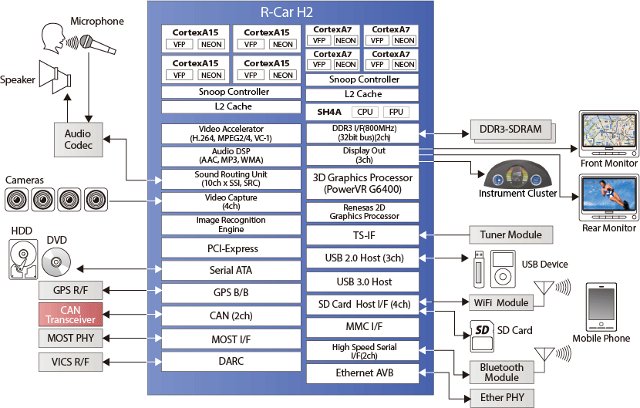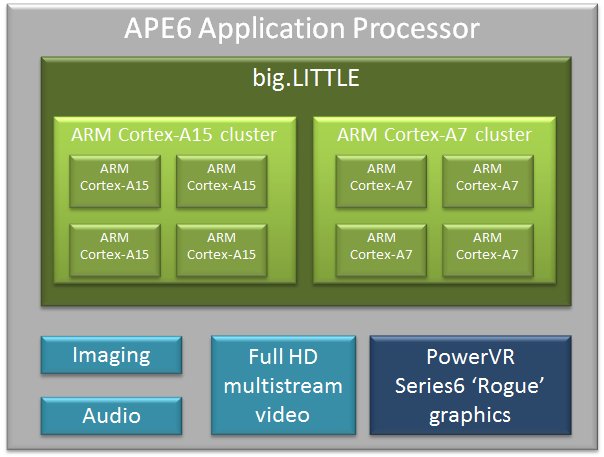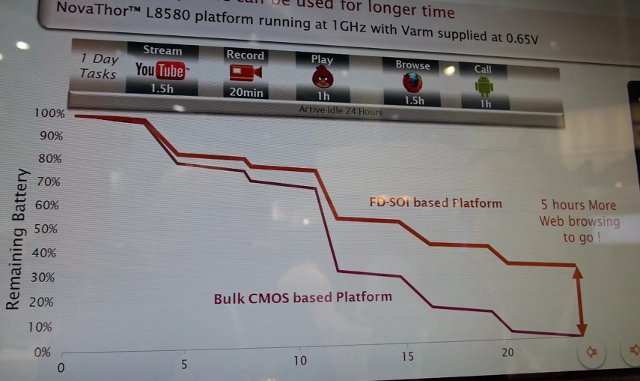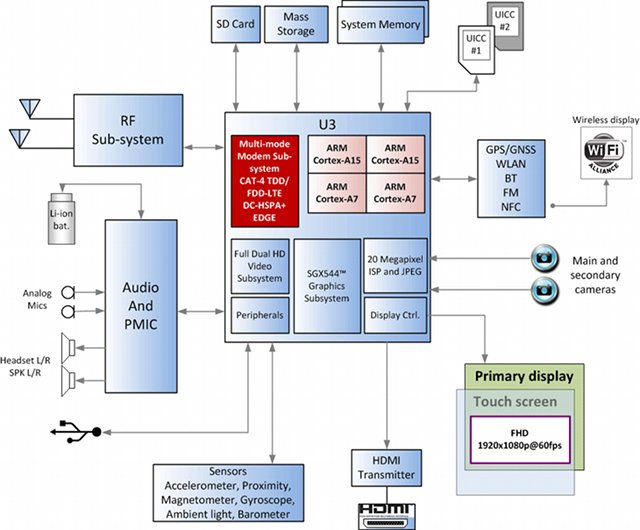Renesas announced a new automotive SoC called the R-Car H2 that features 4 Cortex-A15 cores together with 4 Cortex A7 cores (optional) in big.LITTLE configuration, as well as an Imagination PowerVR Series6 G6400 GPU. This SoC can optionally come with Renesas SH-4A, a real-time processing CPU core acting as a multimedia engine (MME) , and Renesas’ IMP-X4 core, a real-time image processing unit that enables developers to implement augmented reality application such as 360-degree camera views and image recognition. This Renesas processor is a multimedia power house, as it can handle 4x 1080p video en/decoding, including Blu-Ray support at 60 frames per second, as well as image/voice recognition and high-resolution 3D graphics with virtually no CPU usage. Here are R-Car H2’s specifications provided on Renesas website: Product number R8A7790x Power supply voltage 3.3/1.8 V (IO), 1.5/1.35 V (DDR3), 1.0 V (Core) CPU core ARM Cortex-A15 Quad ARM Cortex-A7 Quad (device […]
Linaro 13.02 Release with Linux Kernel 3.8 and Android 4.2.2
Linaro 13.02 is now available, and features Linux Kernel 3.8 and Android 4.2.2. The biggest news this month is probably the first release of a preliminary ARM64 Debian/Ubuntu Raring image. Other noticeable items include work on ARMv7 KVM, more improvements to OpenEmbedded ARMv8 implementation, as well as big.LITTLE MP implementation, and some modifications to the toolchain for Cortex A7 support. Origen images are not available for download this month, and there’s still no ALIP images since they have disappeared since Linaro upgraded to Ubuntu Quantal. Here are the highlights of this release: Android AOSP master build for Galaxy Nexus has been setup All the platforms have been updated to 4.2.2 Support for lava-test-shell has been added to linaro-android-build-tools. Developer Platform CI bring up: ARMv7 KVM – Add Arndale hypervisor patch to u-boot-linaro. CI bring up: Arndale – Add Arndale image reports to LAVA, Enable and verify UEFI support in the […]
Renesas Unveils APE6 Octo Core big.LITTLE Processor
Samsung Exynos 5 Octa processor is getting some competition with the announcement of Renesas AP6 processor at MWC2013. This SoC comes with the same big.LITTLE configuration (4x Cortex A15, 4x Cortex A7), but with a PowerVR SGX Series 6 ‘Rogue’ GPU, which, I assume, should outperform PowerVR SGX544MP3 GPU used in Samsung SoC. R-Mobile APE6 could be the fastest mobile processor announced to date, and is currently showcased at Imagination Technologies booth at MWC 2013 running several OpenGL ES 3.0 applications, as well as a demonstration of Rightware’s Kanzi Studio, “a PC-based real-time WYSIWYG editor for designers and embedded engineers to create and customize embedded 3D user interface”. There’s very little information about the processor, so that’s basically all I have for now. But before I conclude, I’ll just drop a performance comparison chart between different PowerVR SGX series (source), since it’s the first mobile processor that I know of […]
ST Ericsson NovaThor L8580 Dual Core Processor To Match big.LITTLE Quad Core Processors Performance and Power Consumption
ST Ericsson already showcased NovaThor L8580 Cortex A9 processor @ 2.8 GHz at CES 2013. The processor features a technology called eQuad, and as I previously noticed there’s no mention of the number of cores at all on the website and many websites reported the processor featured 4 cores. The processor actually features 2 Cortex A9 core, but thanks to FD-SOI technology they are able to do the equivalent of a Quad Core big.LITTLE processor (i.e. 2x Cortex A15 + 2x Cortex A7) electrically. Since this is just done electrically, you can use the same software as before and will consume much less power, whereas big.LITTLE requires a lot of kernel work. A Cortex A9 will obviously be less powerful than a Cortex A15, but since they are able to boost the frequency up to 3GHz (probably limited to 2.5Ghz in actual product) this can compensate the lower performance, and […]
Renesas Mobile Introduces MP6530 Quad Core ARM big.LITTLE Communication Processor
Renesas Mobile has recently announced the MP6530, an LTE communication SoC that targets mid- to high-end smartphones priced between $200 and $400. MP6530 features big.LITTLE technology with 2 ARM Cortex A15 clocked up to 2GHz, and 2 Cortex A7 cores up to 1Ghz, as well as an Imagination Technology PowerVR SGX544 GPU. Compared to Renesas Mobile MP5232 platform (Dual Cortex A9 + PowerVR GPU + Same TD-LTE Cat-4 Modem), GPU performance and memory performance have both been increased by 300 percent. MP6530 is manufactured using 28nm technology. Other key features of MP6530 SoC include: Dual-channel LPDDR3-standard interface with a bandwidth of 800-MB/s per channel. Multimedia capabilities Full HD primary display up to FHD@60Hz Simultaneous HDMI/MHL external display output (1080p30) Full HD WiFi Display Support for simultaneous 1080p30 video encoding and decoding Up to 20 MP digital SLR-like imaging support On-the-fly support with real-time face detection, stabilization, noise filtering to replace […]
ARM big.LITTLE Processing Demo (HMP) on ARM TC2 Test Chip
Samsung launched Exynos 5 Octa at CES 2013. This processor comes with 8 cores: 4 Cortex A15 cores and 4 Cortex A7 cores, and it’s the first processor that’s been announced to work in big.LITTLE configuration, where the big cores (A15) handle demanding tasks, and the LITTLE cores (A7) handle simpler tasks such as audio playback or background tasks. This is all done to optimize power consumption. There are 2 big.LITTLE software implementations: In-kernel switcher (IKS) and heterogeneous multi-processing (HMP). The first one is easier to implements but can only use 4 cores (in Exynos 5 Octa) at a time, and the second is more complex, but can handle all 8 cores, and assign individual tasks to a particular core. For more technical details about big.LITTLE implementations, you can read my previous post. ARM and Samsung recently uploaded a video providing an overview of big.LITTLE (but instead of IKS and […]
Linaro Connect Asia 2013 Sessions and Mini-Summits
Linaro Connect Asia 2013 (LCA13) will take place in Hong Kong again this year, on March 4 – 8, 2013 at the Gold Coast Hotel. Linaro recently published the event schedule, with sessions focused on kernel, power management, toolchain, graphics and multimedia, platform, validation, and QA tracks, as well as 2 mini-summits: Linaro Enterprise Group (LEG) which will discuss about ARM server, and an as-yet-unannounced group (Linaro Networking Group?) within Linaro. There will also be hacking sessions each day (except on “Demo Friday”) where you can certainly expect to learn many useful skills/tips. I’ve selected 2 sessions or keynotes per day that I think could be especially interesting. Some of the sessions don’t have description yet, so even if they might seem interesting I’ve usually skipped those. Monday 12:00 – 13:00 – Low Level Virtual Machine (LLVM) Update The Toolchain Working Group started working on LLVM in January 2013. Come […]
Linux Conference Australia and FOSDEM 2013 Videos are Now Online
FOSDEM 2013 took place last week, and the organizers are in the process of uploading videos. Up to now, 5 main tracks sessions have been uploaded (Firefox OS; Free, open, secure and convenient communications; FreedomBox 1.0; Samba 4; and systemd, Two Years Later) as well as over 20 lightning talks. You can find the videos at http://video.fosdem.org/2013. You may also want to check my previous post for a lists of interesting talks, and I’ll probably feature some FOSDEM 2013 videos in this blog, at least the open source GPU driver talk. Linux Conference Australia took place on January 28 – February 1, 2013, and the 5-day conference featured lots of talks including several dealing with graphics in Linux, and one developer apparently trashing X in terms of complexity and performance, and explaining how Wayland was better. Others Linux sessions dealt with subject such as 3D printing, supercomputing, Arduino, big.LITTLE processing, […]








